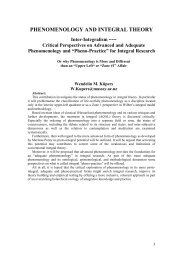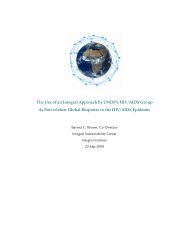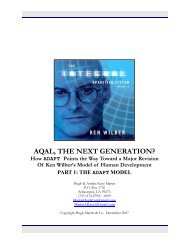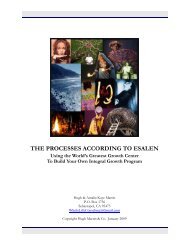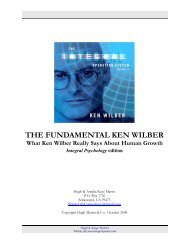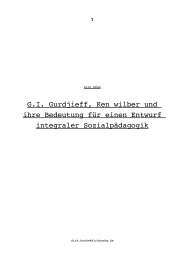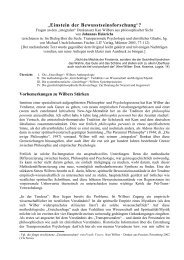Altered States and Subtle Bodies in the One-Scale ... - Integral World
Altered States and Subtle Bodies in the One-Scale ... - Integral World
Altered States and Subtle Bodies in the One-Scale ... - Integral World
You also want an ePaper? Increase the reach of your titles
YUMPU automatically turns print PDFs into web optimized ePapers that Google loves.
<strong>Altered</strong> <strong>States</strong> <strong>and</strong> <strong>Subtle</strong> <strong>Bodies</strong> <strong>in</strong> <strong>the</strong> <strong>One</strong>-<strong>Scale</strong> Modelby Jim O'ConnorIntroductionThis article is <strong>in</strong>tended as a small supplement to my previous essay "Development <strong>in</strong> <strong>the</strong> <strong>One</strong>-<strong>Scale</strong> Model". it attempts to address <strong>the</strong> issue of altered states, peak experiences <strong>and</strong> subtlebodies, show<strong>in</strong>g how <strong>the</strong>y might be accounted for <strong>in</strong> <strong>the</strong> one-scale model outl<strong>in</strong>ed by AndrewSmith.<strong>Altered</strong> <strong>States</strong> Dur<strong>in</strong>g <strong>the</strong> Emergence of <strong>the</strong> CentaurIn <strong>the</strong> one-scale model development from <strong>the</strong> mental-ego to <strong>the</strong> centaur occurs by a process ofregression through which <strong>the</strong> hierarchical structure of <strong>the</strong> psyche is deconstructed <strong>and</strong> holonsfrom all previous stages <strong>in</strong>tegrated around a new center (<strong>the</strong> Self). [1]fur<strong>the</strong>rmore, it appears that as this new, m<strong>and</strong>alic, structure emerges <strong>the</strong> psyche ga<strong>in</strong>s a greaterfluidity that allows it to shift more easily <strong>and</strong> spontaneously <strong>in</strong>to various altered states ofconsciousness. In fact as <strong>the</strong> process of regression proceeds <strong>and</strong> a new center beg<strong>in</strong>s to emergewith<strong>in</strong> <strong>the</strong> psyche, non-ord<strong>in</strong>ary states of consciousness often occur <strong>in</strong> conjunction with a deeperlevel of heal<strong>in</strong>g, re-organisation <strong>and</strong> <strong>in</strong>tegration with<strong>in</strong> <strong>the</strong> body-m<strong>in</strong>d. [2]A very wide range of non-ord<strong>in</strong>ary states of consciousness occur <strong>in</strong> this way, <strong>in</strong>clud<strong>in</strong>gexperiences of <strong>the</strong> psychedelic variety, mystical experiences such as those of cosmicconsciousness, various shamanic experiences <strong>and</strong> so on.As this process of transformation nears completion <strong>the</strong>se states tend to settle down <strong>and</strong> becomemore contemplative <strong>and</strong> pleasurable <strong>in</strong> nature. <strong>the</strong>y become what <strong>the</strong> Buddhist tradition wouldcategorise as states of absorption, or dhyana. It seems likely that this capacity for absorptionresults from <strong>the</strong> <strong>in</strong>tegration of pre-personal stages of development, a characteristic of which is agreater degree of fusion of self <strong>and</strong> world.The Buddhist tradition separates <strong>the</strong> dhyanas <strong>in</strong>to two dist<strong>in</strong>ct sets; <strong>the</strong> dhyanas of form, <strong>and</strong>those which are formless, with each set be<strong>in</strong>g fur<strong>the</strong>r sub-divided <strong>in</strong>to four dist<strong>in</strong>ct stages <strong>and</strong>with all eight be<strong>in</strong>g experienced <strong>in</strong> a l<strong>in</strong>ear progression. (<strong>in</strong> <strong>the</strong> rema<strong>in</strong>der of this article I refer to<strong>the</strong>se states as <strong>the</strong> first dhyana through to <strong>the</strong> eighth dhyana)It is generally held that <strong>the</strong> eight dhyanas are not <strong>in</strong> <strong>the</strong>mselves experiences of <strong>the</strong> transpersonal.For example, a Buddhist writer might refer to <strong>the</strong>m as belong<strong>in</strong>g to <strong>the</strong> mundane sphere ra<strong>the</strong>rthan <strong>the</strong> transcendental. The dhyanas are <strong>the</strong>refore to be viewed as occurr<strong>in</strong>g with<strong>in</strong> <strong>the</strong> mentallevelself, <strong>and</strong> most usually with<strong>in</strong> <strong>the</strong> centaur.Tak<strong>in</strong>g <strong>the</strong> dhyanas <strong>in</strong>to account <strong>the</strong>n, we need to differentiate between two major varieties ofspiritual experience <strong>and</strong> accomplishment - those based around non-ord<strong>in</strong>ary <strong>and</strong> dhyanic states of
consciousness, which can occur with<strong>in</strong> <strong>the</strong> mental-level self, <strong>and</strong> those which arise from amovement <strong>in</strong>to <strong>the</strong> transpersonal.As I suggested <strong>in</strong> <strong>the</strong> ma<strong>in</strong> essay, <strong>the</strong> major determ<strong>in</strong>ant for whe<strong>the</strong>r a movement <strong>in</strong>to <strong>the</strong>transpersonal level has occurred is <strong>the</strong> awaken<strong>in</strong>g of <strong>the</strong> kundal<strong>in</strong>i energy, which should not beconfused with <strong>the</strong> resurgence of libid<strong>in</strong>al energies experienced dur<strong>in</strong>g <strong>the</strong> process of regression.For although experientially very easy to dist<strong>in</strong>guish from one ano<strong>the</strong>r, <strong>the</strong>se phenomenon can beconfused when compared through verbal description.Briefly, <strong>the</strong> resurgence of libid<strong>in</strong>al energies is felt as fairly diffuse waves of energy swirl<strong>in</strong>gupwards through <strong>the</strong> trunk region whereas <strong>the</strong> awaken<strong>in</strong>g of <strong>the</strong> kundal<strong>in</strong>i is felt as a veryconcentrated beam of energy mov<strong>in</strong>g <strong>in</strong> a determ<strong>in</strong>ed l<strong>in</strong>ear fashion directly up <strong>the</strong> sp<strong>in</strong>e. Theresurgence of libid<strong>in</strong>al energies also tends to be a more gradual process, whereas <strong>the</strong> kundal<strong>in</strong>iawaken<strong>in</strong>g has <strong>in</strong>stant consciousness-alter<strong>in</strong>g effects.Therefore, any descriptions of mystical experiences which do not explicitly refer to kundal<strong>in</strong>iphenomenon should be regarded as <strong>in</strong>dicative of a non-ord<strong>in</strong>ary or dhyanic state with<strong>in</strong> <strong>the</strong>centaur ra<strong>the</strong>r than as a movement <strong>in</strong>to <strong>the</strong> transcendental.Similarities Between Dhyanic <strong>States</strong> <strong>and</strong> Transpersonal StagesBut even though dhyanic <strong>and</strong> transpersonal are different realms of experience, <strong>the</strong>re are some<strong>in</strong>terest<strong>in</strong>g correspondences between <strong>the</strong>m. Once aga<strong>in</strong> it is a case of <strong>the</strong> two varieties be<strong>in</strong>gexperientially easy to differentiate, yet descriptively very easy to confuse. However, <strong>the</strong> onescalemodel is able both to differentiate <strong>the</strong>se two classes <strong>and</strong> to suggest a relationship between<strong>the</strong>m that offers an <strong>in</strong>trigu<strong>in</strong>g explanation for <strong>the</strong>ir similarities.To expla<strong>in</strong> this it is first necessary to outl<strong>in</strong>e <strong>the</strong> major experiential features of <strong>the</strong> first fourdhyanas, which can be summarised as follows:FirstDhyanaJoy, Rapture, Bliss, Some thought rema<strong>in</strong>sSecondDhyanaThirdDhyanaRapture, Bliss, No thought, Inspiration/Heal<strong>in</strong>g energies enter<strong>in</strong>g from outside("Stage of <strong>the</strong> Artist") often <strong>in</strong> <strong>the</strong> form of encounters with div<strong>in</strong>e be<strong>in</strong>gs <strong>and</strong>forces.Equanimity, Happ<strong>in</strong>ess, Dwell<strong>in</strong>g <strong>in</strong> source of previous <strong>in</strong>spiration ("Stage of<strong>the</strong> Mystic")FourthDhyanaEquanimity, Complete absorption, Beyond pleasure/pa<strong>in</strong> opposites[3]We can see that <strong>the</strong> movement from joy <strong>and</strong> rapture, through peace <strong>and</strong> equanimity <strong>and</strong> <strong>the</strong>
eventual culm<strong>in</strong>ation <strong>in</strong> a non-dual type state is a clear analogue of <strong>the</strong> process of transpersonalgrowth. The encounter with various archetypal be<strong>in</strong>gs <strong>and</strong> forces also strongly echoesdevelopment around <strong>the</strong> subtle stage of <strong>the</strong> transpersonal, although <strong>in</strong> this case <strong>the</strong> encounteredbe<strong>in</strong>gs are more "earth bound" than <strong>the</strong> transcendental archetypes. [4]So, if <strong>the</strong>se states are not transpersonal developments <strong>the</strong>n how are <strong>the</strong>y to be conceived of <strong>and</strong>why <strong>the</strong> existence of such strik<strong>in</strong>g similarities? Well, recall<strong>in</strong>g that <strong>in</strong> <strong>the</strong> ma<strong>in</strong> essay I suggestedthat consciousness/spirit is an entity that emerges at <strong>the</strong> transpersonal level of <strong>the</strong> holarchy <strong>and</strong>flows downwards <strong>in</strong>to lower order holons [5], ano<strong>the</strong>r possibility naturally arises. That is, wecould suggest that each dhyana arises as a successively higher stage of spirit is brought down<strong>in</strong>to <strong>the</strong> centauric body-m<strong>in</strong>d. In o<strong>the</strong>r words <strong>the</strong> dhyanas are <strong>the</strong> result of <strong>the</strong> centaur becom<strong>in</strong>g<strong>in</strong>fused with successively higher forms of spirit. So joy, rapture <strong>and</strong> bliss arise from br<strong>in</strong>g<strong>in</strong>g <strong>the</strong>psychic-stage down <strong>in</strong>to <strong>the</strong> centaur; <strong>in</strong>spiration <strong>and</strong> visions of archetypal be<strong>in</strong>gs from <strong>the</strong> subtlestage; <strong>and</strong> equanimity <strong>and</strong> non-dual type perception arise from allow<strong>in</strong>g <strong>the</strong> highest transpersonalstage, <strong>the</strong> causal witness, to descend.Tak<strong>in</strong>g this fur<strong>the</strong>r we could <strong>the</strong>n suggest that <strong>the</strong> formless dhyanas are <strong>the</strong> result of br<strong>in</strong>g<strong>in</strong>gdown <strong>in</strong>to <strong>the</strong> centaur <strong>the</strong> various layers of <strong>the</strong> level above <strong>the</strong> transpersonal. This level Isuggested heralds <strong>the</strong> emergence of a property I termed empt<strong>in</strong>ess, so aga<strong>in</strong> <strong>the</strong> correlation seemspromis<strong>in</strong>g.There are fur<strong>the</strong>r similarities between <strong>the</strong> structure of <strong>the</strong> dhyanas <strong>and</strong> <strong>the</strong> structure of <strong>the</strong>transpersonal that lend weight to this explanation, which I'll outl<strong>in</strong>e briefly.1. Firstly, <strong>in</strong> <strong>the</strong> ma<strong>in</strong> essay we noted that <strong>in</strong> Smith's model <strong>in</strong>dividual development progressesthrough discrete levels, with a similar pattern occurr<strong>in</strong>g <strong>in</strong> each. Borrow<strong>in</strong>g a term fromGurdjieff, I loosely referred to this phenomenon as "octaves of development", <strong>and</strong> it is<strong>in</strong>terest<strong>in</strong>g to note that someth<strong>in</strong>g similar appears to occur with<strong>in</strong> <strong>the</strong> dhyanas, with <strong>the</strong> dhyanasof form mak<strong>in</strong>g up one octave, <strong>and</strong> <strong>the</strong> formless dhyanas mak<strong>in</strong>g up <strong>the</strong> octave above.
For example, <strong>in</strong> her book "Who is my self", Buddhist nun Ayya Khema outl<strong>in</strong>es two aspects ofdhyanic development that po<strong>in</strong>t to a similar pattern repeat<strong>in</strong>g itself throughout <strong>the</strong> two sets. Thefirst of <strong>the</strong>se aspects is a progression from sensation to emotion that occurs dur<strong>in</strong>g <strong>the</strong> lowerstages of each level, <strong>and</strong> <strong>the</strong> second is a progression <strong>in</strong> <strong>the</strong> type of self-sense experienced dur<strong>in</strong>gdevelopment through each set. Regard<strong>in</strong>g <strong>the</strong> first of <strong>the</strong>se Khema says:"We can compare <strong>the</strong> fifth <strong>and</strong> sixth [dhyanas] with <strong>the</strong> first <strong>and</strong> second absorptions. When wehave a delightful sensation, joy arises. All we have to do is shift our attention from <strong>the</strong> sensationto <strong>the</strong> emotion, which is already present <strong>and</strong> just needs our awareness. In <strong>the</strong> fifth <strong>and</strong> sixthjhana, it is <strong>the</strong> same, only on a subtler level, for <strong>the</strong> absorptions become progressively f<strong>in</strong>ertuned." [6]And regard<strong>in</strong>g <strong>the</strong> self-sense experienced at each stage:"<strong>One</strong> consciousness we are aware of [<strong>in</strong> human existence] is <strong>the</strong> one experienced <strong>in</strong> <strong>the</strong>[dhyanas]. It is for this reason that <strong>the</strong> dhyanas are mundane, not yet transcendental. They are notwithout "me." All <strong>the</strong> dhyanas are of this nature; sometimes stronger, sometimes less so. In <strong>the</strong>first three absorptions <strong>the</strong> "me" aspect is very pronounced; less so <strong>in</strong> <strong>the</strong> fourth. It becomesstrong aga<strong>in</strong> <strong>in</strong> <strong>the</strong> fifth, sixth <strong>and</strong> seventh, but on a different level. .. In <strong>the</strong> eighth absorption, <strong>the</strong>"me" consciousness is very weak." [7]So <strong>the</strong> dhyanas appear to occur <strong>in</strong> two dist<strong>in</strong>ct octaves.Many o<strong>the</strong>r <strong>in</strong>terest<strong>in</strong>g correspondences emerge here also. Firstly, <strong>the</strong> move from sensation toemotion occurs at <strong>the</strong> correspond<strong>in</strong>g po<strong>in</strong>t <strong>in</strong> dhyanic development to where it occurs <strong>in</strong>"vertical" growth. In addition to this, we also note that <strong>the</strong> "me" aspect (self-sense) becomesweakest at <strong>the</strong> po<strong>in</strong>t where a dhyana arises from br<strong>in</strong>g<strong>in</strong>g down <strong>the</strong> stage of spirit associated withan autonomous holon. It is <strong>the</strong>se types of small correspondences that suggest <strong>the</strong> model is a goodfit to experience.
Ano<strong>the</strong>r po<strong>in</strong>ter to <strong>the</strong> dhyanas form<strong>in</strong>g two dist<strong>in</strong>ct octaves is that with <strong>the</strong> move from form toformless <strong>the</strong>re is a marked qualitative shift <strong>in</strong> <strong>the</strong> nature of <strong>the</strong> experience. As Jack Kornfieldputs it:"After develop<strong>in</strong>g skill <strong>in</strong> <strong>the</strong> first four levels of absorption that result from <strong>the</strong>se [meditationobjects], it is possible to open to even more ref<strong>in</strong>ed states. The Elders call <strong>the</strong> next four levels <strong>the</strong>Absorptions Beyond Forms, where consciousness releases any meditation subject altoge<strong>the</strong>r <strong>and</strong>exp<strong>and</strong>s to experience boundless dimensions of exquisite silent <strong>and</strong> pure awareness." [8]The experiences associated with each of <strong>the</strong> formless dhyanas can be summarised as follows:Fifth dhyana (first formless dhyana)Sixth dhyana (second formless dhyana)Seventh dhyana (third formless dhyana)Eighth dhyana (fourth formless dhyana)Boundless SpaceLimitless ConsciousnessSphere of no-th<strong>in</strong>gnessNei<strong>the</strong>r Perception nor Non-perceptionThis shift <strong>in</strong> <strong>the</strong> nature of <strong>the</strong> dhyanas fits very well with <strong>the</strong> fact that <strong>in</strong> <strong>the</strong> one-scale model <strong>the</strong>major levels of <strong>in</strong>dividual development are discrete entities, with completely different types ofdevelopment occurr<strong>in</strong>g <strong>in</strong> each. Therefore, as this is <strong>the</strong> case <strong>in</strong> "vertical" development, it makessense that a similar marked qualitative change should occur <strong>in</strong> dhyanic development also.
Ano<strong>the</strong>r piece of evidence which supports this view of <strong>the</strong> dhyanas is that some teachers see bothas be<strong>in</strong>g processes with no endpo<strong>in</strong>t. For example, <strong>in</strong> <strong>the</strong> ma<strong>in</strong> essay we noted that Buddhistteacher <strong>and</strong> writer Sangharakshita says of transcendental development:"Enlightenment is, ..., but <strong>the</strong> far<strong>the</strong>st po<strong>in</strong>t on our horizon, over which <strong>the</strong> Buddhas appear. Aswe approach nearer to that horizon, however, it recedes from us <strong>and</strong> <strong>the</strong> Buddhas appear over it<strong>in</strong> ever more subtle <strong>and</strong> glorious forms." [9]We would <strong>the</strong>refore expect <strong>the</strong> process of develop<strong>in</strong>g dhyana to be similarly open-ended, wi<strong>the</strong>ach new state be<strong>in</strong>g <strong>the</strong> result of br<strong>in</strong>g<strong>in</strong>g down progressively higher forms of spirit, empt<strong>in</strong>ess<strong>and</strong> so on. And accord<strong>in</strong>g to Sangharakshita aga<strong>in</strong>, this is <strong>in</strong>deed <strong>the</strong> case:"In pr<strong>in</strong>ciple <strong>the</strong> process of ref<strong>in</strong>ement of consciousness [develop<strong>in</strong>g dhyana] can be extended<strong>in</strong>def<strong>in</strong>itely, <strong>and</strong> an <strong>in</strong>f<strong>in</strong>ite progress of ever more subtle states could be enumerated." [10]3. The f<strong>in</strong>al correspondence between dhyanic <strong>and</strong> "vertical" development that I would like topo<strong>in</strong>t out is that <strong>the</strong>re is a sense <strong>in</strong> which successive dhyanas transcend <strong>and</strong> <strong>in</strong>clude previousones. This is conveyed by <strong>the</strong> term passaddhi whereby <strong>the</strong> rapture released <strong>in</strong> meditationgradually becomes conta<strong>in</strong>ed with<strong>in</strong> wider experiences of bliss, calm <strong>and</strong> eventually, equanimity.Buddhist writer Kamalashila describes <strong>the</strong> process of passaddhi as follows:"The occurrence of rapture <strong>and</strong> bliss show that <strong>in</strong>creased concentration is an <strong>in</strong>tensely enjoyableexperience. It is <strong>in</strong>terest<strong>in</strong>g to see how bliss arises out of rapture. As absorption takes a firmerhold, <strong>the</strong> experience of bliss becomes larger, as it were, so that it <strong>in</strong>creas<strong>in</strong>gly 'conta<strong>in</strong>s' <strong>the</strong>feel<strong>in</strong>gs of rapture. This process of conta<strong>in</strong>ment is known as passaddhi, <strong>and</strong> it is through<strong>in</strong>creased passaddhi that <strong>the</strong> concentration will deepen fur<strong>the</strong>r, The deepen<strong>in</strong>g bliss graduallyassimilates <strong>the</strong> bubbly, thrill<strong>in</strong>g energy that is released <strong>in</strong> <strong>the</strong> experience of rapture. The processof passaddhi makes one's m<strong>in</strong>d pliable, flexible, <strong>and</strong> very easily worked with, It is a matur<strong>in</strong>g,streng<strong>the</strong>n<strong>in</strong>g quality, very characteristic of higher states of consciousness, <strong>and</strong> important <strong>in</strong>meditation generally." [11]So <strong>the</strong>re do appear to be some very promis<strong>in</strong>g po<strong>in</strong>ters towards this idea that <strong>the</strong> dhyanas arisefrom br<strong>in</strong>g<strong>in</strong>g down higher forms of spirit <strong>in</strong>to <strong>the</strong> centauric body-m<strong>in</strong>d.However, <strong>the</strong>re is one correspondence between transcendental <strong>and</strong> dhyanic development thatwould be expected but which I have so far been unable to determ<strong>in</strong>e <strong>the</strong> existence of. This is, if<strong>the</strong> f<strong>in</strong>al stage of any level of "vertical" development is an <strong>in</strong>tegration of all <strong>the</strong> previous stagesof <strong>the</strong> level, we might expect a similar phenomenon to occur with <strong>the</strong> dhyanas. That is, we mightexpect <strong>the</strong> fourth dhyana, for example, to conta<strong>in</strong> aspects similar to each of <strong>the</strong> previous threedhyanas. Although I have not been able to f<strong>in</strong>d any evidence po<strong>in</strong>t<strong>in</strong>g to this be<strong>in</strong>g <strong>the</strong> case, wehave already noted that with <strong>the</strong> f<strong>in</strong>al dhyana of each 'octave' <strong>the</strong>re is a qualitative shift <strong>in</strong> <strong>the</strong>type of self sense experienced, which tends to suggest that this f<strong>in</strong>al state has a different structureto <strong>the</strong> previous three. Whe<strong>the</strong>r this structural difference is one of autonomous vs <strong>in</strong>termediateholon is ano<strong>the</strong>r question.
However, even without any evidence of this expected f<strong>in</strong>d<strong>in</strong>g, I th<strong>in</strong>k <strong>the</strong> correspondencesoutl<strong>in</strong>ed above are strik<strong>in</strong>g enough to allow us to use this explanation of <strong>the</strong> dhyanas as awork<strong>in</strong>g hypo<strong>the</strong>sis, <strong>and</strong> once aga<strong>in</strong> I would po<strong>in</strong>t out how it arises very naturally from <strong>the</strong> onescalemodel.<strong>Subtle</strong> <strong>Bodies</strong>If higher levels of spirit brought down <strong>in</strong>to <strong>the</strong> centaur manifest <strong>in</strong> experience as states ofabsorption, <strong>the</strong>n we could also consider <strong>the</strong> possibility that <strong>the</strong>y manifest <strong>in</strong> <strong>the</strong> physicalorganism as <strong>the</strong> phenomenon of subtle bodies.More specifically we could say that as an <strong>in</strong>dividual develops through <strong>the</strong> mental <strong>and</strong>transpersonal levels of <strong>the</strong> holarchy, <strong>the</strong>se higher-order entities endow <strong>the</strong> lower-order holon, <strong>the</strong>organism, with <strong>the</strong> various bodies, or koshas of Vedanta H<strong>in</strong>duism. So an <strong>in</strong>dividual beg<strong>in</strong>s with<strong>the</strong> physical organism, <strong>the</strong> annamayakosha, <strong>and</strong> subsequently develops <strong>the</strong> pranamayakosha as<strong>the</strong> libid<strong>in</strong>al energies of <strong>the</strong> organism are awakened <strong>in</strong> very early <strong>in</strong>fancy. Then, as <strong>the</strong> <strong>in</strong>dividualdevelops through <strong>the</strong> mental-level, <strong>the</strong> manomayakosha (<strong>the</strong> sheath of m<strong>in</strong>d) emerges.The f<strong>in</strong>al sheath, <strong>the</strong> an<strong>and</strong>amayakosha, or sheath of Transcendental bliss, beg<strong>in</strong>s to develop as<strong>the</strong> <strong>in</strong>dividual reaches <strong>the</strong> mature centaur stage of development <strong>and</strong> spirit flows downwards <strong>in</strong>to<strong>the</strong> body-m<strong>in</strong>d. It is <strong>the</strong>n fur<strong>the</strong>r developed by cont<strong>in</strong>u<strong>in</strong>g to br<strong>in</strong>g down higher stages of spirit,ei<strong>the</strong>r my ascend<strong>in</strong>g <strong>in</strong>to <strong>the</strong> transpersonal level directly or by develop<strong>in</strong>g <strong>the</strong> dhyanas.The phenomenon of subtle bodies <strong>the</strong>refore has a simple explanation with<strong>in</strong> <strong>the</strong> one-scale model.Implications for Aurob<strong>in</strong>doIf <strong>the</strong> nature of <strong>the</strong> dhyanas is <strong>in</strong>deed as suggested above <strong>the</strong>n we can underst<strong>and</strong> why <strong>the</strong>y aresaid to prepare <strong>the</strong> body-m<strong>in</strong>d for movement <strong>in</strong>to <strong>the</strong> transpersonal. That is, by mak<strong>in</strong>g <strong>the</strong> bodym<strong>in</strong>dable to conta<strong>in</strong> spiritual energies, <strong>the</strong>y lessen <strong>the</strong> need for it to rapidly adjust to <strong>the</strong>seenergies dur<strong>in</strong>g transpersonal development, where <strong>the</strong> process is often less gentle.This view of <strong>the</strong> dhyanas also suggests that Aurob<strong>in</strong>do's system of spiritual development, whichfirst <strong>in</strong>volves br<strong>in</strong>g<strong>in</strong>g spirit down <strong>in</strong>to <strong>the</strong> body-m<strong>in</strong>d before awaken<strong>in</strong>g <strong>the</strong> kundal<strong>in</strong>i energy, amethod which is sometimes claimed to be unique to Aurob<strong>in</strong>do [12], is actually equivalent todevelop<strong>in</strong>g dhyana as a prerequisite to transpersonal development as would be practiced <strong>in</strong> mostBuddhist schools, for example.It should also be possible to survey o<strong>the</strong>r traditions to determ<strong>in</strong>e how <strong>the</strong>y fit <strong>in</strong>to <strong>the</strong> one-scalemodel - for example, <strong>the</strong> Taoist practice of "circulat<strong>in</strong>g <strong>the</strong> light" [13] would be seen as br<strong>in</strong>g<strong>in</strong>gspirit down <strong>in</strong>to <strong>the</strong> body-m<strong>in</strong>d <strong>and</strong> develop<strong>in</strong>g dhyana, ra<strong>the</strong>r than as a transpersonal path.
The Pre-Trans Fallacy Aga<strong>in</strong>The <strong>in</strong>clusion of states of dhyana with<strong>in</strong> our schema of development adds an extra level ofcomplexity to <strong>the</strong> Pre-Trans Fallacy, which I th<strong>in</strong>k now looks as follows:i) Any pre-personal stage can be mistaken for <strong>the</strong> equivalent structure <strong>in</strong>tegrated with<strong>in</strong> <strong>the</strong>centaur. For example, <strong>the</strong> magic stage has two manifestations with<strong>in</strong> mental-level development.First, when it is identified with dur<strong>in</strong>g prepersonal development, <strong>and</strong> secondly when it takes itsplace as an <strong>in</strong>tegrated aspect of <strong>the</strong> centaur.ii) The pre-personal stage can also be mistaken for <strong>the</strong> equivalent stage <strong>in</strong> transpersonaldevelopment, as outl<strong>in</strong>ed by Ken Wilber <strong>in</strong> <strong>the</strong> general PTF.And we now also have <strong>the</strong> follow<strong>in</strong>g:iii) A particular stage of dhyana can be mistaken for its correspond<strong>in</strong>g stage of transpersonaldevelopment. For example, <strong>the</strong> third dhyana, or "stage of <strong>in</strong>spiration", can be mistaken for <strong>the</strong>subtle stage of <strong>the</strong> transpersonal.I believe that <strong>in</strong> his work Ken Wilber tends to overlook <strong>the</strong> dhyanas <strong>and</strong> that where he doesmention <strong>the</strong>m he erroneously <strong>in</strong>terprets <strong>the</strong>m as temporary ascents <strong>in</strong>to <strong>the</strong> transcendental, whichis a PTF of type iii.Because Ken has now elevated dhyana to <strong>the</strong> status of <strong>the</strong> transcendental, his analysis of alteredstates is miss<strong>in</strong>g this important class of experiences. This leads him to claim, for example, thataltered states generally show no development at all [14], a statement which appears to overlook<strong>the</strong> dhyanas completely.Michael Washburn also addresses <strong>the</strong> dhyanas <strong>in</strong> his work <strong>and</strong> recognises that <strong>the</strong>y occur with<strong>in</strong><strong>the</strong> centauric structure, but mistakes <strong>the</strong>m for transpersonal development, which is also a PTF oftype iii.Similarly, Allan Combs also mistakes dhyana for transpersonal development, or at least this is<strong>the</strong> implication from <strong>the</strong> map of development outl<strong>in</strong>ed <strong>in</strong> his excellent book The Radiance ofBe<strong>in</strong>g [15].However, <strong>the</strong> paradigms of both Washburn <strong>and</strong> Combs are still valid models of development upto <strong>the</strong> centaur <strong>and</strong> <strong>in</strong>to <strong>the</strong> dhyanas; <strong>and</strong> Wilber's paradigm is still correct <strong>in</strong> mapp<strong>in</strong>g <strong>the</strong> trulytranscendental stages of development above, ra<strong>the</strong>r than with<strong>in</strong>, <strong>the</strong> centaur.The Importance of DhyanaNone of <strong>the</strong> above is <strong>in</strong>tended to understate <strong>the</strong> importance <strong>and</strong> value of dhyanic development.On <strong>the</strong> contrary, dhyana can progress to <strong>the</strong> po<strong>in</strong>t of cosmic consciousness <strong>and</strong> beyond, <strong>and</strong> canbe used as <strong>the</strong> basis for develop<strong>in</strong>g psychic abilities, as well as prepar<strong>in</strong>g <strong>the</strong> body-m<strong>in</strong>d fortranscendental development <strong>and</strong> form<strong>in</strong>g <strong>the</strong> basis of a spiritualised embodied life.
However, we can now see that <strong>the</strong> one-scale model is able to differentiate <strong>the</strong>se two str<strong>and</strong>s ofspiritual development <strong>and</strong> clarify what <strong>the</strong>y both represent, how <strong>the</strong>y are <strong>in</strong>terrelated <strong>and</strong> how<strong>the</strong>y can become confused with one o<strong>the</strong>r. It also allows us <strong>the</strong> possibility of flesh<strong>in</strong>g out ourprogramme of <strong>in</strong>dividual development slightly to add detail to <strong>the</strong> spiritualisation of <strong>the</strong> bodym<strong>in</strong>d.[16].I would suggest that, amongst o<strong>the</strong>r th<strong>in</strong>gs, dhyanic development allows an <strong>in</strong>dividual to enter<strong>in</strong>to a more spiritual relationship with his worldspace <strong>and</strong> to become sensitive to <strong>the</strong> varioussubtle energies etc <strong>in</strong> <strong>the</strong> environment. More specifically, I would say that because ourworldspace is <strong>the</strong> higher-order holon <strong>in</strong> which we are embedded, this gross realm should itself beconscious <strong>in</strong> some sense, <strong>and</strong> possess its own form of subtle body. Spiritualis<strong>in</strong>g <strong>the</strong> body-m<strong>in</strong>d,<strong>the</strong>refore, allows us to contact this consciousness, whe<strong>the</strong>r <strong>in</strong> <strong>the</strong> form of <strong>the</strong> Tao, <strong>the</strong> CosmicM<strong>in</strong>d <strong>and</strong> so on <strong>and</strong> harmonise our actions with it.Mov<strong>in</strong>g to <strong>the</strong> transcendental level, we can see that <strong>in</strong>dividuals engag<strong>in</strong>g <strong>in</strong> transpersonaldevelopment are <strong>in</strong>volved <strong>in</strong> a process of harmonis<strong>in</strong>g <strong>the</strong>ir actions with manifest existence as awhole as well as with <strong>the</strong> cosmic m<strong>in</strong>d of <strong>the</strong> gross realm, <strong>and</strong> that <strong>the</strong> spiritualisation of <strong>the</strong>body-m<strong>in</strong>d forms <strong>the</strong> <strong>in</strong>terface between <strong>the</strong> two. By contact<strong>in</strong>g successively higher forms ofspirit <strong>and</strong> <strong>in</strong>tegrat<strong>in</strong>g <strong>the</strong>se with<strong>in</strong> <strong>the</strong> centaur, an <strong>in</strong>dividual is able to harmonise her actions withprocesses occur<strong>in</strong>g <strong>in</strong> progressively higher order holons. These activities thus orig<strong>in</strong>ate from anever widen<strong>in</strong>g underst<strong>and</strong><strong>in</strong>g of <strong>the</strong> human situation, <strong>and</strong> are focused toward participat<strong>in</strong>g <strong>in</strong>cosmic evolution with a progressively deeper underst<strong>and</strong><strong>in</strong>g of what this means.Ano<strong>the</strong>r important function of dhyana is that <strong>in</strong> enabl<strong>in</strong>g an <strong>in</strong>dividual to focus his attention onepo<strong>in</strong>tedlyon an object of contemplation dhyana enables him to ga<strong>in</strong> more powerfultranscendental <strong>in</strong>sight than would o<strong>the</strong>rwise be possible. In many Buddhist <strong>in</strong>sight meditationtraditions it is said that dhyana is <strong>in</strong> fact <strong>in</strong>dispensable <strong>in</strong> this regard.Implications for Collective DevelopmentAs already stated, <strong>in</strong> <strong>the</strong> one-scale model <strong>the</strong> <strong>in</strong>dividual is a component of a higher-order holon.In Andy's view this higher-order holon is human society; I like to po<strong>in</strong>t out that when peoplebeg<strong>in</strong> <strong>in</strong>teract<strong>in</strong>g <strong>the</strong>y create a worldspace <strong>and</strong> that this can be considered an emergent at <strong>the</strong>mental level <strong>and</strong> treated as part of <strong>the</strong> holon. Speak<strong>in</strong>g loosely, we can say that this worldspace<strong>the</strong>n 'descends' <strong>in</strong>to <strong>the</strong> <strong>in</strong>dividual organisms, endow<strong>in</strong>g <strong>the</strong>m with mentality.The next level of <strong>the</strong> holarchy consists of <strong>the</strong> entity aris<strong>in</strong>g from <strong>the</strong> <strong>in</strong>teractions of vast numbersof <strong>the</strong>se worldspaces, with spirit be<strong>in</strong>g <strong>the</strong> emergent of <strong>the</strong> level. Spirit itself <strong>the</strong>n flows down<strong>in</strong>to lower-order holons, endow<strong>in</strong>g <strong>the</strong>m with consciousness. The descent of spirit is hamperedwhen it encounters a lower-order holon that is not yet autonomous, however, this is offset by <strong>the</strong>fact that higher emergents are more fluid <strong>and</strong> thus more tenacious <strong>in</strong> <strong>the</strong>ir downflow<strong>in</strong>g.Because <strong>in</strong> <strong>the</strong> one-scale model holons on different levels display some analogous features, we
might look to see if our <strong>in</strong>terpretation of <strong>the</strong> dhyanas offers any po<strong>in</strong>ters as to how <strong>the</strong>spiritualisation of a worldspace might proceed.I have already suggested that such psychic phenomenon as <strong>the</strong> Tao, subtle energies, <strong>the</strong> AkashicRecord <strong>and</strong> so on are <strong>the</strong> result of our worldspace be<strong>in</strong>g a vehicle for consciousness <strong>and</strong> that<strong>the</strong>se features are evidence of a k<strong>in</strong>d of subtle body. In <strong>the</strong> one-scale model we would expect thatas our realm is still pre-<strong>in</strong>tegral, that it's ability to mediate consciousness <strong>in</strong> this way wouldcurrently be limited, <strong>and</strong> that such phenomena are at this time rudimentary <strong>in</strong> nature whencompared to those that would be expected <strong>in</strong> an <strong>in</strong>tegral worldspace.If our worldspace does <strong>in</strong>deed beg<strong>in</strong> to move toward a more <strong>in</strong>tegral form, <strong>and</strong> <strong>in</strong> so do<strong>in</strong>g itdoes beg<strong>in</strong> to become spiritualised, it may be possible to draw some general hypo<strong>the</strong>ses about<strong>the</strong> effects of this process by analogy with <strong>the</strong> changes that take place <strong>in</strong> an <strong>in</strong>dividual engaged <strong>in</strong>dhyanic development.To do so, Ill suggest that we can summarise <strong>the</strong> effects of dhyana on an <strong>in</strong>dividual as aprogressive widen<strong>in</strong>g <strong>and</strong> ref<strong>in</strong><strong>in</strong>g of <strong>the</strong> centauric structure. We might <strong>the</strong>refore look to see howa widen<strong>in</strong>g <strong>and</strong> ref<strong>in</strong><strong>in</strong>g of an <strong>in</strong>tegral worldspace might proceed.Firstly, an obvious parallel is that just as <strong>the</strong> descent of spirit <strong>in</strong>to an <strong>in</strong>dividual offers anexpansion of awareness, right up to cosmic consciousness <strong>and</strong> beyond, it may offer someth<strong>in</strong>gsimilar to a whole society by widen<strong>in</strong>g its shared worldspace beyond <strong>the</strong> bounds of <strong>the</strong> planet.Although this may sound quite "far-out", clearly someth<strong>in</strong>g like it has already begun <strong>in</strong> our owncase, both through <strong>the</strong> space-program, but also through <strong>the</strong> emergence of various cosmic <strong>the</strong>meswith<strong>in</strong> popular culture - <strong>the</strong> 'Star-Trek' phenomenon - both of which we could offer as evidencethat our collective awareness is beg<strong>in</strong>n<strong>in</strong>g to exp<strong>and</strong> beyond <strong>the</strong> limits of our planet.<strong>One</strong> m<strong>in</strong>or, yet <strong>in</strong>terest<strong>in</strong>g, aspect to this is that <strong>the</strong> artists beh<strong>in</strong>d such work often <strong>in</strong>tuit aconnection between a civilisation mov<strong>in</strong>g <strong>in</strong>to space <strong>and</strong> it develop<strong>in</strong>g an awareness of a spiritualfoundation to existence. We can see this clearly <strong>in</strong> films such as 2001, Star Wars <strong>and</strong> <strong>the</strong> StarTrek series, all of which are very ma<strong>in</strong>stream. It would seem <strong>the</strong>refore that <strong>the</strong>se artists have<strong>in</strong>tuitively drawn a connection that we could also <strong>in</strong>fer from <strong>the</strong> 'dhyana' analogy.Of course, <strong>the</strong> fact that such a widen<strong>in</strong>g appears to have already begun, while our worldspacestill appears to be largely pre-<strong>in</strong>tegral, might suggest that <strong>the</strong> analogy does not quite hold.However, I th<strong>in</strong>k if we allow for a certa<strong>in</strong> amount of overlapp<strong>in</strong>g between subsequentdevelopments, <strong>the</strong> proximity of this phenomenon to <strong>the</strong> <strong>in</strong>tegral stage of our development isreasonably promis<strong>in</strong>g.And secondly, we would expect that an <strong>in</strong>flux of spirit would lead to a ref<strong>in</strong><strong>in</strong>g of ourworldspace.Because a worldspace is at root a l<strong>in</strong>guistic structure made up of <strong>the</strong> objects, rules, beliefs,ideologies <strong>and</strong> so on that def<strong>in</strong>e our experience of <strong>the</strong> world, by analys<strong>in</strong>g how <strong>the</strong>se change <strong>in</strong>
an <strong>in</strong>dividual engaged <strong>in</strong> dhyanic development, we may be able to draw up some hypo<strong>the</strong>sesabout <strong>the</strong> changes likely to occur dur<strong>in</strong>g <strong>the</strong> analogous collective process.A possible start<strong>in</strong>g po<strong>in</strong>t for such a discussion is Gebser's analysis of <strong>the</strong> chang<strong>in</strong>g nature of ourlanguage as we beg<strong>in</strong> to collectively broach <strong>the</strong> <strong>in</strong>tegral stage of our development. Briefly,Gebser saw that l<strong>in</strong>ear, structured narrative was giv<strong>in</strong>g way to more open <strong>and</strong> fluid methods ofcommunication; a decenter<strong>in</strong>g from <strong>the</strong> <strong>in</strong>dividual viewpo<strong>in</strong>t to an aperspectival stance, aloosen<strong>in</strong>g of grammatical conventions; a move to a more dynamic stream-of-consciousnesscommunication <strong>and</strong> so on. [17].In <strong>the</strong> one-scale model we would <strong>the</strong>n expect that this decentered language would itself beg<strong>in</strong> tobecome spiritualised, i.e. more ref<strong>in</strong>ed <strong>and</strong> capable of communicat<strong>in</strong>g spiritual underst<strong>and</strong><strong>in</strong>g<strong>and</strong> experience. This is no longer a vertical transformation of <strong>the</strong> deep structure of language but aprogressive ref<strong>in</strong><strong>in</strong>g of <strong>the</strong> <strong>in</strong>tegral stage.Related to <strong>the</strong> changes <strong>in</strong> language, we would also expect a similar spiritualisation of <strong>the</strong> rules,concepts <strong>and</strong> ideologies with<strong>in</strong> which a particular society is constra<strong>in</strong>ed. For example, at <strong>the</strong>rational stage of a society's development, <strong>the</strong> rules by which it lives are unconscious, rigid <strong>and</strong>dualistic <strong>in</strong> nature, lead<strong>in</strong>g to frustration for <strong>in</strong>dividuals <strong>and</strong> groups as <strong>the</strong>y attempt to realiseparadoxical goals. However, as <strong>the</strong> <strong>in</strong>tegral stage is more fully realised we would expect <strong>the</strong>serigid rules to be superseded by those based on more open systems of logic, lead<strong>in</strong>g to a moreliberated society.We might also expect <strong>the</strong> <strong>in</strong>tensified consciousness of <strong>the</strong> <strong>in</strong>tegral stage to draw attention toareas of conflict <strong>and</strong> contradiction with<strong>in</strong> <strong>the</strong> worldspace, <strong>and</strong> to facilitate reorganisation wherenecessary. This can be viewed as an analogous process to that which occurs <strong>in</strong> an <strong>in</strong>dividual whopractices m<strong>in</strong>dfulness, where consciousness acts as a feedback mechanism, br<strong>in</strong>g<strong>in</strong>g areas ofhidden conflict <strong>in</strong>to awareness <strong>and</strong> facilitat<strong>in</strong>g <strong>the</strong>ir resolution. In <strong>the</strong> collective version this maytake <strong>the</strong> form of a 'reweav<strong>in</strong>g of <strong>the</strong> web of context-dependent objects <strong>in</strong> order to elim<strong>in</strong>ate <strong>the</strong>residual tensions <strong>in</strong> <strong>the</strong> region currently under stra<strong>in</strong>' [18] as our worldspace moves towards amore balanced <strong>and</strong> stable dynamic. I see this awareness be<strong>in</strong>g concentrated largely through <strong>the</strong>spotlight of <strong>the</strong> global media, which is able to focus collective attention on very specific areas ofconflict, be <strong>the</strong>y physical (e.g. <strong>the</strong> Middle East) or ideological (e.g. <strong>the</strong> abortion debate).Although <strong>the</strong>re are a number of factors that distort <strong>the</strong> media's presentation of such issues (e.g.Noam Chomsky's five news filters [19]), as this process is <strong>in</strong> its early stages such edit<strong>in</strong>g <strong>and</strong>deletion can be seen as analogous to <strong>the</strong> cognitive tactics employed by an <strong>in</strong>dividual attempt<strong>in</strong>gto avoid fac<strong>in</strong>g her shadow while at <strong>the</strong> mental-egoic stage of development. We might <strong>the</strong>reforeexpect a less distorted presentation of global issues to emerge <strong>in</strong> <strong>the</strong> media as an <strong>in</strong>herent aspectof <strong>the</strong> move to an <strong>in</strong>tegral society, h<strong>and</strong>-<strong>in</strong>-h<strong>and</strong> with all <strong>the</strong> corporate <strong>and</strong> political(de/)restructur<strong>in</strong>g necessarily implied.As well as its more passive mode of function<strong>in</strong>g, consciousness also <strong>in</strong>cludes an active volitionalaspect, which manifests as a purposeful redesign of <strong>the</strong> worldspace accord<strong>in</strong>g to <strong>the</strong> <strong>in</strong>tentions ofits members. We can possibly see this <strong>in</strong> <strong>the</strong> emergence of techniques of cognitive developmentsuch as N.L.P., which suggest that <strong>in</strong>dividuals are no longer content to function under <strong>the</strong> sway
of limit<strong>in</strong>g <strong>in</strong>herited beliefs, but are attempt<strong>in</strong>g to mold <strong>the</strong>m <strong>in</strong> more positive directions. ErikDavis refers to this as Experience Design <strong>and</strong> l<strong>in</strong>ks it to <strong>the</strong> grow<strong>in</strong>g <strong>in</strong>terest <strong>in</strong> practices ofspiritual development -- many of which can be seen as Experience Design oriented <strong>in</strong> <strong>the</strong>direction of spirit. [20] Some th<strong>in</strong>kers, such as Edward De Bono, are even attempt<strong>in</strong>g tosystematically widen <strong>the</strong> scope of language itself to enable it to more accurately convey <strong>the</strong>nuances of experience <strong>and</strong> thus make it an <strong>in</strong>strument of liberation. [21].As outl<strong>in</strong>ed <strong>in</strong> <strong>the</strong> ma<strong>in</strong> essay, <strong>in</strong> Smith's model <strong>the</strong> <strong>in</strong>tegral (planetary) society is one <strong>in</strong> whichan overall (embedded) hierarchical structure no longer exists, which suggests that a k<strong>in</strong>d ofsocio-political decenter<strong>in</strong>g has occurred. In a society <strong>in</strong> which adult members naturally reach <strong>the</strong><strong>in</strong>tegral stage of development, political responsibility can be withdrawn from outside agencies<strong>and</strong> distributed amongst <strong>in</strong>dividuals co-operat<strong>in</strong>g at various levels. This k<strong>in</strong>d of harmonious,decentralised social <strong>and</strong> political system might <strong>the</strong>n be expected to form <strong>the</strong> basis for <strong>the</strong>emergence of a truly spiritual culture - a Pure L<strong>and</strong> - as <strong>the</strong> web of conceptual structuresunderp<strong>in</strong>n<strong>in</strong>g <strong>the</strong> society become ever more spacious, ref<strong>in</strong>ed <strong>and</strong> oriented <strong>in</strong> <strong>the</strong> direction ofspiritual development.These are a few thoughts on how <strong>the</strong> spiritualisation of a worldspace might proceed <strong>in</strong> <strong>the</strong> onescalemodel. They are not <strong>in</strong>tended to be rigorous <strong>in</strong> any sense, but are simply put forward fordiscussion.References1. As <strong>in</strong> <strong>the</strong> ma<strong>in</strong> essay, I use less rigorous term<strong>in</strong>ology than Andy when discuss<strong>in</strong>g <strong>the</strong> model.Aga<strong>in</strong>, I describe autonomous holons as "non-hierarchical" to convey <strong>the</strong> fact that <strong>the</strong> hierarchyis of <strong>the</strong> non-embedded ra<strong>the</strong>r than embedded variety.2. For example, see:Stanislav Grof, The Cosmic Game (1998), orRalph Metzner, The Unfold<strong>in</strong>g Self (1998)3. This description of <strong>the</strong> dhyanas has been gleaned from three sources:a) Ayya Khema, Who Is My Self? (1997)b) Kamalashila, Meditation (1995)c) Subhuti, Sangharakshita (1994)4. I mean this <strong>in</strong> <strong>the</strong> sense that devas, ancient muses <strong>and</strong> nature spirits are more earthbound than<strong>the</strong> transcendental archetypes.5. Particularly autonomous holons.6. Who Is My Self? p91
7. ibid, p1478. Jack Kornfield, A Path with Heart, p1399. Sangharakshita, p7310. ibid, p19611. Meditation, p7112. Sri Aurob<strong>in</strong>do, The Adventure of Consciousness (1993) p3413. Richard Wilhelm, The Secret of <strong>the</strong> Golden Flower (1984)14. Ken Wilber, A Summary of My Psychological Model. See http://wilber.shambhala.com15. Allan Combs, The Radiance of Be<strong>in</strong>g (1995) p13716. Basically, spiritual development <strong>in</strong> this model is seen as an <strong>in</strong>terplay between <strong>the</strong> follow<strong>in</strong>g:a) The vertical developmental stage reached. e.g. mental-ego, centaur, psychic etcb) The <strong>in</strong>tegration of lower stages <strong>in</strong>to autonomous holons (e.g. centaur, causal witness).c) Infus<strong>in</strong>g autonomous holons with higher order properties (e.g. dhyana).In <strong>the</strong> ma<strong>in</strong> essay I suggested that <strong>the</strong> pr<strong>in</strong>ciple meditation technique for <strong>in</strong>tegrat<strong>in</strong>g lower stages<strong>in</strong>to autonomous holons is <strong>the</strong> contemplation of death (or impermanence, or suffer<strong>in</strong>g, or anyform of dukha).There are two maps that I f<strong>in</strong>d useful for approach<strong>in</strong>g <strong>the</strong> spiritualisation of <strong>the</strong> body-m<strong>in</strong>d. Thefirst is <strong>the</strong> Buddhist tradition's development of <strong>the</strong> positive roots of generosity, lov<strong>in</strong>g k<strong>in</strong>dness<strong>and</strong> wisdom or, to state it <strong>in</strong> negative terms, <strong>the</strong> overcom<strong>in</strong>g of greed, hatred <strong>and</strong> delusion. <strong>the</strong>reare various techniques <strong>in</strong> <strong>the</strong> Buddhist tradition for achiev<strong>in</strong>g this.A somewhat similar approach is suggested by David Brazier <strong>in</strong> his book Zen Therapy (2001).Draw<strong>in</strong>g on <strong>the</strong> work of Carl Rogers, Brazier puts forward <strong>the</strong> view that <strong>the</strong> wholesome roots ofBuddhism correspond to <strong>the</strong> qualities of unconditional positive regard, empathy <strong>and</strong> congruence<strong>in</strong> Rogers' psychological system. If Brazier is correct <strong>the</strong>n it seems that <strong>the</strong> development of <strong>the</strong>sethree qualities is a good strategy by which to achieve a balanced <strong>and</strong> harmonious spiritualisationof <strong>the</strong> body-m<strong>in</strong>d. suggestions for some meditation techniques that could help <strong>in</strong> this regard are:a) Unconditional positive regard - The development of <strong>the</strong> Brahma-viharas, particularly <strong>the</strong>Metta Bhavana.b) Empathy - Exchang<strong>in</strong>g self with o<strong>the</strong>rs.c) Congruence - View<strong>in</strong>g this as a function of <strong>in</strong>tegration - The contemplation of death,m<strong>in</strong>dfulness of breath<strong>in</strong>g <strong>and</strong> o<strong>the</strong>r techniques of one-po<strong>in</strong>ted concentration.When <strong>the</strong> spiritualisation of <strong>the</strong> body-m<strong>in</strong>d has progressed sufficiently, various vipassana
techniques can be employed to achieve entry <strong>in</strong>to <strong>the</strong> transcendental, for example witness<strong>in</strong>gmeditations, <strong>the</strong> six-element practice <strong>and</strong> any o<strong>the</strong>r technique which helps deconstruct <strong>the</strong>exclusive identification with <strong>the</strong> body-m<strong>in</strong>d.A cont<strong>in</strong>uation of <strong>the</strong> same meditation techniques can be used to facilitate growth through <strong>the</strong>transpersonal level, perhaps with <strong>the</strong> addition of visualisation practices <strong>and</strong> <strong>the</strong> <strong>in</strong>clusion of lessstructured forms of meditation such as Zazen.When <strong>the</strong> causal witness has been established, it would seem that entry <strong>in</strong>to <strong>the</strong> level above <strong>the</strong>transpersonal is achieved through a cont<strong>in</strong>uation once aga<strong>in</strong> of vipassana meditation, perhapswith <strong>the</strong> addition of koan-type practices.17. There are of course many <strong>in</strong>stances of post-modern literature that could be used to illustrateGebser's po<strong>in</strong>t. <strong>One</strong> good recent example is <strong>the</strong> first chapter of Don Delillo's Underworld (1997).Many of Gebser's observations on aperspectival language can be seen <strong>in</strong> Delillo's description of<strong>the</strong> baseball game; <strong>the</strong> multiple viewpo<strong>in</strong>ts; <strong>the</strong> stream of consciousness approach; <strong>the</strong> l<strong>in</strong>guisticfreedom ("Frank deadpans <strong>the</strong> page to Gleason") <strong>and</strong> so on.18. Joroen Maes, Human Rights Democratisation <strong>and</strong> Citizenship (2002). Seehttp://www.vub.ac.be/boerplato/jeroenscriptie.html19. Edward S. Herman & Noam Chomsky, Manufactur<strong>in</strong>g Consent (1994) ch120. Experience Design <strong>and</strong> <strong>the</strong> Design of Experience, Erik Davis 2002. Seehttp://www.techgnosis.com/experience.html21. Edward De Bono, The De Bono Code Book (2001)



